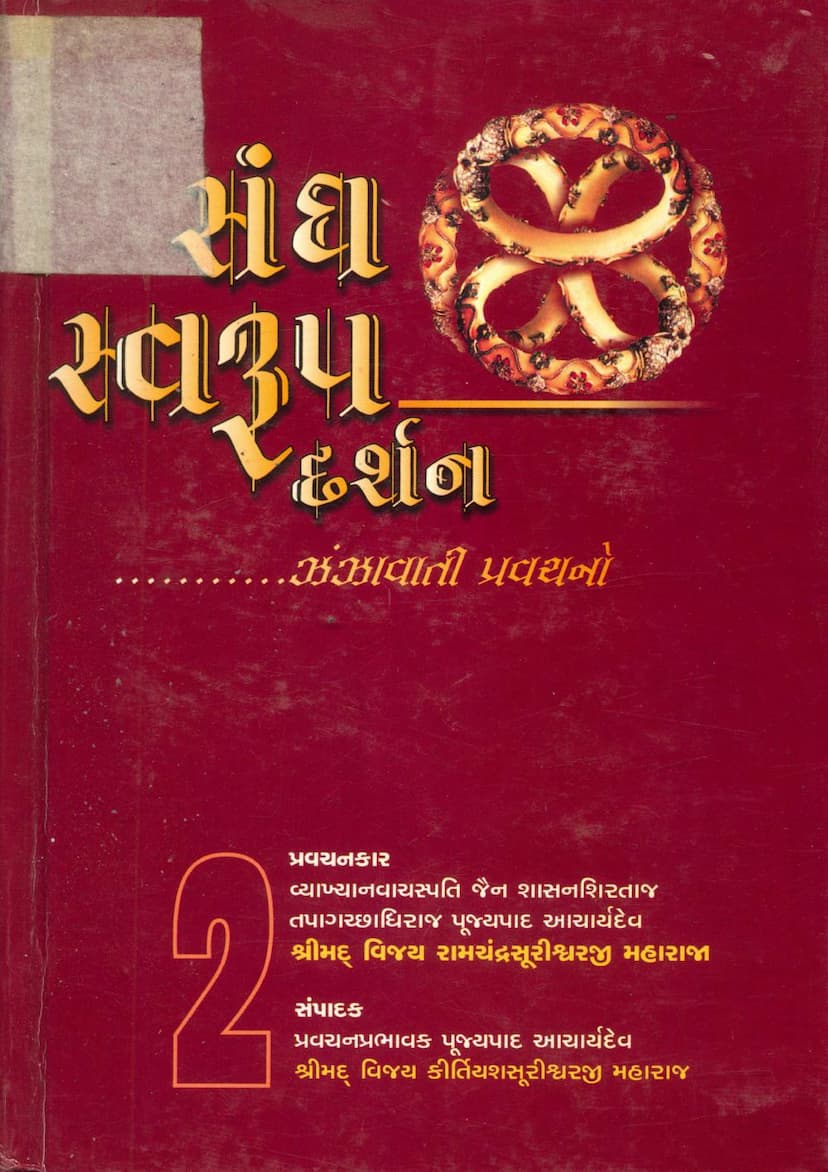Sangh Swarup Darshan Part 02
Added to library: September 2, 2025

Summary
Certainly! Here's a comprehensive summary in English of the Jain text "Sangh Swarup Darshan Part 02" by Kirtiyashsuri, based on the provided pages:
Book Title: Sangh Swarup Darshan Part 02 Author: Kirtiyashsuri Publisher: Sanmarg Prakashan
This summary is based on the provided text from the Jain Education International. The document is a collection of discourses by Acharya Shrimad Vijay Ramchandrasurishwarji Maharaj, compiled and edited by Acharya Shrimad Vijay Kirtiyashsurishwarji Maharaj. The text focuses on understanding the true nature and duties of the Jain Sangh (community).
Overall Theme:
The core theme of the text is to elucidate the multifaceted nature, significance, and responsibilities of the Jain Sangh, which is composed of four constituent parts: monks (Sadhus), nuns (Sadhvis), laymen (Shravaks), and laywomen (Shravikas). The discourses emphasize that a true Sangh is one that adheres strictly to the teachings of Lord Mahavir and the Jain Agamas, regardless of personal convenience or worldly opinions.
Key Concepts and Sections Summarized:
The text progresses through several key concepts, addressing potential misunderstandira is and deviations from true Jain principles. Here's a breakdown of the major points covered:
-
The Nature of Sangh: The Sangh is described as a majestic entity, revered by deities and even venerated by the Tirthankaras. It's compared to a city for its security, a chariot for its progression on the path to liberation, a lotus for its detachment from worldly impurities, and the sun and moon for its brilliance and stability. The core principle is adherence to Jinendra's (Lord Mahavir's) commandments.
-
The Five Defects and Their Eradication: The text identifies five defects that can weaken the foundation of the Sangh (represented by the "Pith" or base of Mount Meru, symbolizing the body of principles). These defects are:
- Shanka (Doubt): Doubt in the teachings of the Tirthankaras.
- Kanksha (Desire): Desire for worldly comforts and attractions, even leading to preference for other philosophies.
- Vichikitsa (Disgust/Criticism): Disparaging the practices of monks or the teachings due to ignorance or aversion.
- Mithyatva Prashansa (Praise of Falsehood): Praising and promoting false doctrines or individuals who deviate from the path.
- Mithyatva Parichaya (Association with Falsehood): Associating with individuals or groups promoting false views. The importance of adhering to the true teachings and avoiding these defects for maintaining a strong spiritual foundation is highlighted.
-
The Role of Virtues and Discipleship: The text emphasizes the importance of strong faith (Shraddha) and adherence to the path shown by the enlightened ones (Tirthankaras, Acharyas, etc.). It stresses the need for individuals to diligently follow the teachings, even when facing difficulties or temptations. The concept of "Abhaykumar" and his renunciation of worldly pleasures due to the influence of his grandfather and the teachings of Lord Mahavir is cited as an example of genuine renunciation and spiritual understanding.
-
The Nature of True Renunciation and Attachment: The discourses differentiate between true renunciation (Vairagya) and mere outward displays. True renunciation stems from an understanding of the impermanence of worldly pleasures and the soul's eternal nature. It critiques those who seek worldly comforts while professing spiritual goals. The importance of detachment from worldly possessions and desires is repeatedly stressed.
-
The Contrast Between Worldly and Spiritual Pursuit: The text highlights how worldly pursuits, driven by desire and attachment, lead to suffering and further entanglement in the cycle of birth and death. Conversely, spiritual pursuits, rooted in detachment and wisdom, lead to liberation and true happiness. The discourses use analogies like the elephant and the lotus to illustrate these points.
-
The Importance of Right Conduct and Intention: The text underscores that mere rituals or external actions are insufficient if the underlying intention or mindset is not aligned with the true principles of Jainism. Sincere devotion, right faith, and right conduct are crucial for spiritual progress.
-
Critique of Misinterpretations and Deviations: The discourses address various misinterpretations and deviations from Jain principles that were prevalent, often attributed to a desire for convenience or worldly attachment. It criticizes the tendency to adapt religious practices to suit personal whims or contemporary trends, emphasizing that the core teachings of the Tirthankaras are eternal and immutable.
-
The Dangers of False Association and Blind Faith: The text warns against blindly following individuals or philosophies that deviate from the path of Jainism. It highlights the importance of critical thinking and discernment, guided by the Agamas and the teachings of the enlightened ones. Praising false doctrines or those who promote them is considered detrimental to spiritual progress.
-
The Significance of the Sangh: The discourses emphasize the collective strength and responsibility of the Sangh. It's portrayed as a vital institution for preserving and propagating Jain principles. Every member, from monks to lay followers, has a role to play in upholding the integrity and spiritual mission of the Sangh.
-
The Concept of 'Bhava Sangh': The text distinguishes between an outward Sangh and a true spiritual community ('Bhava Sangh') which is based on inner conviction, adherence to Jain teachings, and righteous conduct, regardless of numbers.
-
The Ultimate Goal – Moksha: The entire discourse is geared towards guiding the listener towards understanding the path to Moksha (liberation). The inherent impermanence of worldly existence and the ultimate bliss of Moksha are presented as motivations for spiritual discipline.
Overall Message:
"Sangh Swarup Darshan Part 02" is a profound spiritual guide that aims to instill a deep understanding of the Jain way of life, the importance of the Sangh, and the individual's role in spiritual progress. It urges readers to cultivate right faith, right knowledge, and right conduct, emphasizing the eternal relevance of Tirthankara teachings in navigating the cycle of existence towards liberation. The text serves as a reminder that true spiritual progress comes from sincere devotion, diligent practice, and unwavering adherence to the path of non-violence and detachment, as exemplified by the Tirthankaras and Acharuyas.